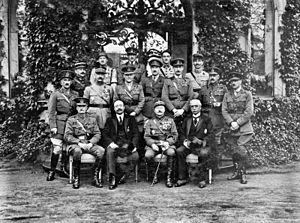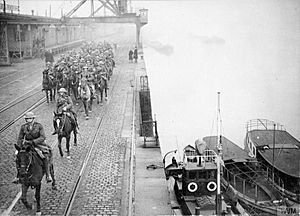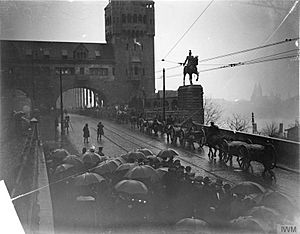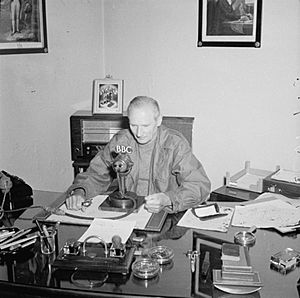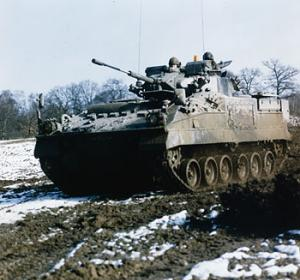British Army of the Rhine facts for kids
Quick facts for kids British Army of the Rhine |
|
|---|---|
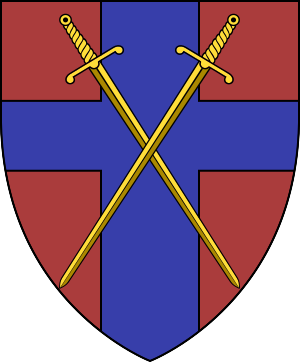 |
|
| Active | 1919–1929 1945–1994 |
| Country | |
| Branch | |
| Part of | British Army |
| Garrison/HQ | JHQ Rheindahlen, Germany |
The British Army of the Rhine (BAOR) was the name for British military forces stationed in Germany. There were two different times this name was used. Both times, the BAOR was an army that occupied (stayed in) parts of Germany. This happened after the First World War and again after the Second World War. Both groups of soldiers were based near the River Rhine in Germany.
Contents
History of the BAOR
After the First World War (1919–1929)
The first British Army of the Rhine was created in March 1919. Its job was to help manage the occupation of the Rhineland area of Germany after the First World War.
At first, this army was very large. It had five main groups of soldiers, called corps. Each corps had two divisions, plus there was a separate cavalry division. Over time, many of these units were sent home. By February 1920, the BAOR mainly consisted of regular army battalions.
In August 1920, Winston Churchill, who was in charge of the army at the time, told Parliament that the BAOR had about 13,360 soldiers. These troops included cavalry, artillery, engineers, infantry, and other support teams. They were mostly based around the city of Cologne. A newspaper called The Cologne Post was even published for the soldiers there.
From 1922, the BAOR was organized into two smaller groups called brigades: the 1st Rhine Brigade and the 2nd Rhine Brigade. These brigades included various famous British regiments.
Commanders-in-chief (1918–1929)
These are some of the top commanders who led the BAOR during this time:
- Field Marshal Lord Plumer (1918–1919)
- General Sir William Robertson (1919–1920)
- General Sir Thomas Morland (1920–1922)
- General Sir Alexander Godley (1922–1924)
- General Sir John Du Cane (1924–1927)
- General Sir William Thwaites (1927–1929)
After the Second World War (1945–1994)
The second British Army of the Rhine was created on August 25, 1945. It was formed from the British Liberation Army, which had fought in the Second World War. Its first job was to help control the military government in the British part of Allied-occupied Germany.
Once German civilians took over the government, the BAOR's role changed. It became the main command for British troops in Germany. As the threat of a Soviet invasion into West Germany grew, the BAOR's main focus shifted. It became responsible for defending West Germany, not just occupying it.
The BAOR was a key part of NATO (North Atlantic Treaty Organization) after the alliance was formed in 1949. Its main fighting force was British I Corps. From 1952, the BAOR's commander was also in charge of NATO's Northern Army Group (NORTHAG) if a major war with the Soviet Union and its allies (the Warsaw Pact) broke out. The BAOR even had tactical nuclear weapons for a time. In 1967, the number of soldiers in the force was reduced to 53,000, down from 80,000 ten years earlier.
After the Cold War (Post 1994)
When the Cold War ended, the need for such a large army in Germany decreased. In 1993, the British government made defense cuts called "Options for Change." Because of these changes, the BAOR was made much smaller. In 1994, it was renamed British Forces Germany.
This new force had about 25,000 soldiers. It included the headquarters for a rapid reaction force, the 1st Armoured Division, and other support units. Many garrisons (military bases) were closed down at this time, such as those in Soest, Soltau, and Minden.
After another review in 2010, the British Army began to remove its permanent units from Germany. The last military base was given back to the German army (Bundeswehr) in February 2020.
Commanders-in-chief (1945–1994)
Here are some of the top commanders who led the BAOR during this period:
- Field Marshal Viscount Montgomery (1945–1946)
- Lieutenant General Sir Richard McCreery (1946–1948)
- Lieutenant General Sir Brian Horrocks (1948)
- Lieutenant General Sir Charles Keightley (1948–1951)
- General Sir John Harding (1951–1952)
- General Sir Richard Gale (1952–1957)
- General Sir Dudley Ward (1957–1960)
- General Sir James Cassels (1960–1963)
- General Sir William Stirling (1963–1966)
- General Sir John Hackett (1966–1968)
- General Sir Desmond Fitzpatrick (1968–1970)
- General Sir Peter Hunt (1970–1973)
- General Sir Harry Tuzo (1973–1976)
- General Sir Frank King (1976–1978)
- General Sir William Scotter (1978–1980)
- General Sir Michael Gow (1980–1983)
- General Sir Nigel Bagnall (1983–1985)
- General Sir Martin Farndale (1985–1987)
- General Sir Brian Kenny (1987–1989)
- General Sir Peter Inge (1989–1992)
- General Sir Charles Guthrie (1992 – May 1994)
Garrisons (Military Bases)
Some of the places where British soldiers were based in Germany included:
- Bergen-Hohne Garrison
- Osnabrück Garrison
- Westfalen Garrison
See also
- British military history
- Canadian Forces Europe
- Mixed Service Organisation


